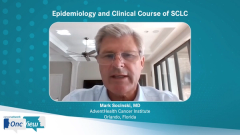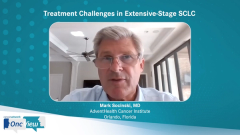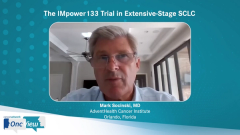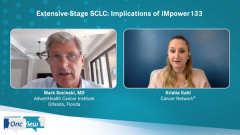
Small Cell Lung Cancer: Standard of Care
Dr Benjamin Levy describes common treatment approaches for patients with limited-stage small cell lung cancer and extensive-stage small cell lung cancer.
Episodes in this series

Kristie Kahl: I want to shift gears to the standard of care. What is the standard of care for small cell lung cancer at the various stages of the disease?
Benjamin Levy, MD: For limited-stage small cell lung cancer, the standard of care hasn’t budged over the past 10 or 15 years. We generally want to deliver concurrent chemoradiation. The radiation oncologist can decide whether it’s twice-a-day radiation or daily radiation, although there have been data that twice-daily radiation may be better. Then it’s chemotherapy with platinum-etoposide concurrently with radiation. Generally, when we’re going for cure, I try to give cisplatin-based chemotherapy rather than carboplatin, although there are data that suggest that carboplatin may be as good as cisplatin in the limited-stage setting, certainly in the extensive-stage setting. So, we generally offer concurrent chemoradiation. We give the chemotherapy concurrently while they’re getting the radiation. The question is, for limited-stage lung cancer, should we offer what we call “prophylactic cranial irradiation” to the brain? We should at least make that referral to the radiation oncologist to have that discussion. We know that PCI, prophylactic cranial irradiation, improves survival for limited-stage small cell lung cancer. It’s a risk-benefit discussion with the radiation oncologist once the chemoradiation is complete.
For extensive-stage lung cancer, the treatment options have evolved. The same platinum-etoposide that I mentioned, and is used concurrently with radiation, has also been the cornerstone treatment for extensive-stage lung cancer. Generally, carboplatin or cisplatin is given on day 1, etoposide is given on day 1, 2, and 3, and it’s given every 21 days for 4 cycles. Prior to the advent of immunotherapy, we really didn’t have any other strategies. We’ve looked at maintenance strategies. We’ve looked at continuing chemotherapy beyond 4 cycles, and we really haven’t made many gains to this strategy.
Of course, recently, we had the advent of immunotherapy, which we’ll talk about in the next segments. This has really moved the field forward over the last 2, 3, 4 years. For patients with extensive-stage lung cancer, the standard used to be platinum-etoposide followed by nothing. Now the standard is platinum-etoposide for 4 to 6 cycles, watch, and then maybe consider using prophylactic cranial irradiation for extensive stage. In an extensive stage cancer, unlike limited stage, PCI has a smaller significant benefit, and newer data suggest it probably shouldn’t be used. But recently we’ve had 2 studies that have shown that if you add immunotherapy to platinum-etoposide regimens and compared that with platinum-etoposide alone, there is an improvement in outcome. That, for sure, has changed the paradigm for patients with extensive-stage small cell lung cancer. We’ll certainly talk about the IMpower and the CASPIAN study.
In the second 1, we have new treatment options for patients, at least for extensive-stage disease. A drug called lurbinectedin has been recently evaluated in a phase 2 study looking at single-agent activity of this drug after platinum-etoposide for patients who have resistance on platinum-etoposide. The evaluation shows meaningful outcomes, with response rates that are north of 40%, and the survival is anywhere from 9 to 12 months. That’s in the platinum-refractory setting. The phase 3 study of lurbinectedin, unfortunately, was a negative study. This drug got approved based on a phase 2 study, but then the phase 3 was negative. It’s still there to be used, but when a head-to-head comparison was done with topotecan, it did not show a survival advantage. Nevertheless, given that we do not have any second-line drugs that really work in extensive-stage small cell lung cancer, I would make the argument that separate of a clinical trial, lurbinectedin should be considered for patients.
Kristie Kahl: If you take a look back over the past 10, even 20 years, how have the treatment options for this disease evolved?
Benjamin Levy, MD: As I mentioned, I would say there are 2 fronts. One is the addition of immunotherapy with checkpoint inhibitors that have improved survival in the front line. Clearly, I/O [immuno-oncology] therapy has made a meaningful impact for patients in the front line. Second would be the role of second-line drugs, like lurbinectedin, which have shown response rates anywhere from 30% to 40% in refractory patients to platinum-etoposide. We have some new second-line options that are available. Then there are other strategies that are being looked at. One of the things that has weaved its way into some of these trials is the role of consolidative radiation.
If patients get platinum-etoposide, have a nice response from platinum-etoposide with I/O, and have a nice response in the lung, there should be a role for consolidative radiation. The data have been mixed on that and runs right up to the role of immunotherapy as well because we’re usually, in these patients, continuing the immunotherapy and not breaking for radiation. But there may be a role also for radiation as well. All these strategies—I/O strategies, second-line strategies, and potentially radiation—may play some role to continue moving forward. We didn’t have these in the past 5 to 10 years, and it’s changed recently, in a positive direction, for our patients.
Kristie Kahl: Definitely. What have we learned about predictive factors for treatment response? In particular, does biomarker testing play a role in the treatment decision-making for extensive-stage small cell lung cancer?
Benjamin Levy, MD: Yeah, this is another important distinction with non–small cell lung cancer. If you take non–small cell lung cancer, you can parse out non–small cell lung cancer into distinct genetic subsets that can be wedded to what we call “genotype-directed therapies” or “targeted therapies.” Even patients who don’t have a genotype but have a high PD-L1 with non–small cell lung cancer can potentially be offered a single-agent checkpoint inhibitor. This has not been the case with small cell lung cancer. Unfortunately, we are still scratching the surface and only have a nascent understanding of reliable predictive biomarkers, either in tissue or plasma, that may help us decide. A lot of data and from the IMpower study look at plasma TMB [tumor mutational burden] and PD-L1. None of these seemed to predict response to immunotherapy, the newer agents. Prior to immunotherapy, we didn’t have a lot of predictive factors, either in tissue or plasma, that played a role. I think this will change.
We’re coming up with, potentially, 4 distinct subsets genetically of small cell lung cancer, and 1 of these subsets may be responsive to PARP inhibitors. But the standard is you really don’t need to test for PD-L1 in small cell and you don’t need to do any genetic testing right now. This may change soon. You also don’t need to look for anything in the plasma. Right now, general treatment for all patients with extensive-stage small cell lung cancer is offering them platinum-etoposide with, preferably, an I/O agent if the patient is I/O eligible and then continuing that I/O until progression.
Transcript edited for clarity.
Newsletter
Stay up to date on recent advances in the multidisciplinary approach to cancer.







































































































